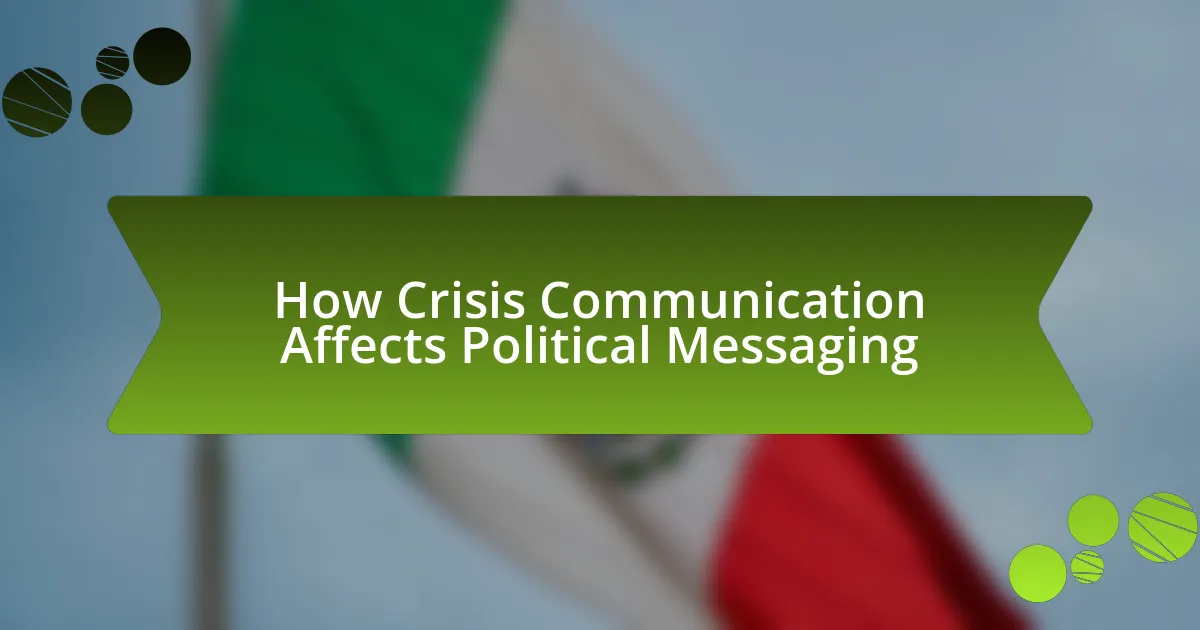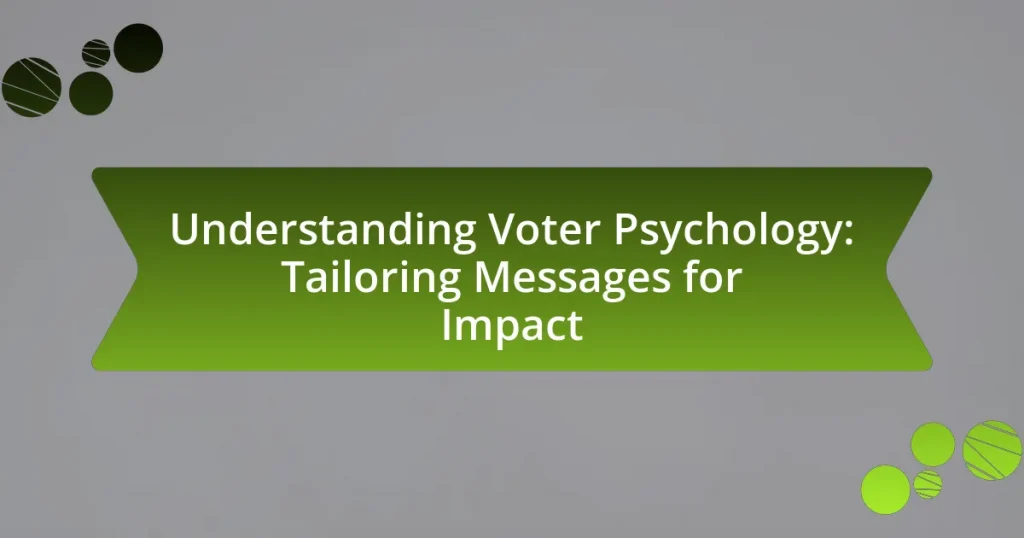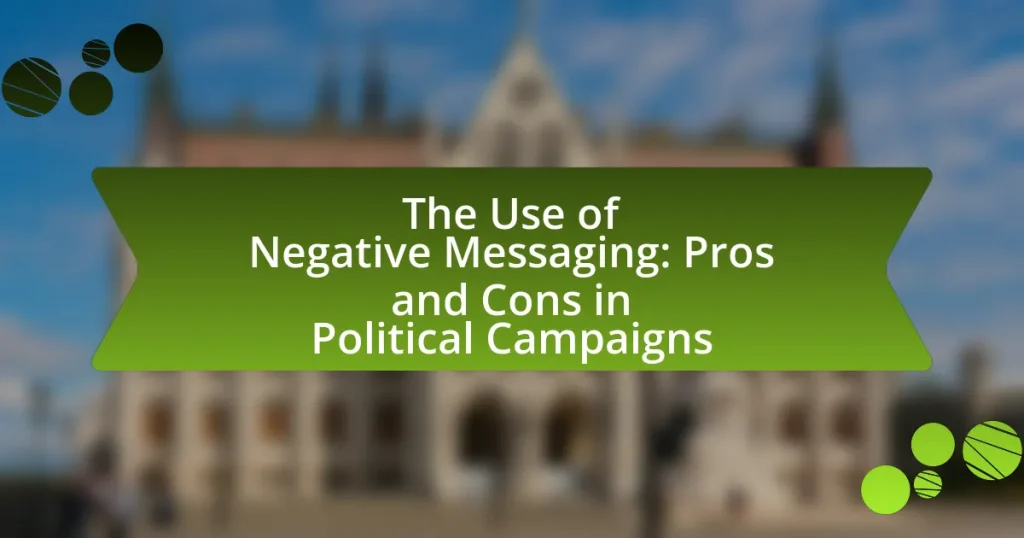Crisis communication is a strategic approach used by political entities to manage information during crises, aiming to mitigate damage and maintain public trust. The article explores how effective crisis communication influences political narratives, shapes public perception, and impacts political outcomes, highlighting key elements such as timely dissemination, transparency, and empathy. It examines the role of media in crisis communication, the evolution of political messages during crises, and best practices for political leaders to prepare for potential crises. Additionally, it discusses historical examples and common mistakes to avoid, providing practical tips for enhancing crisis communication strategies in politics.
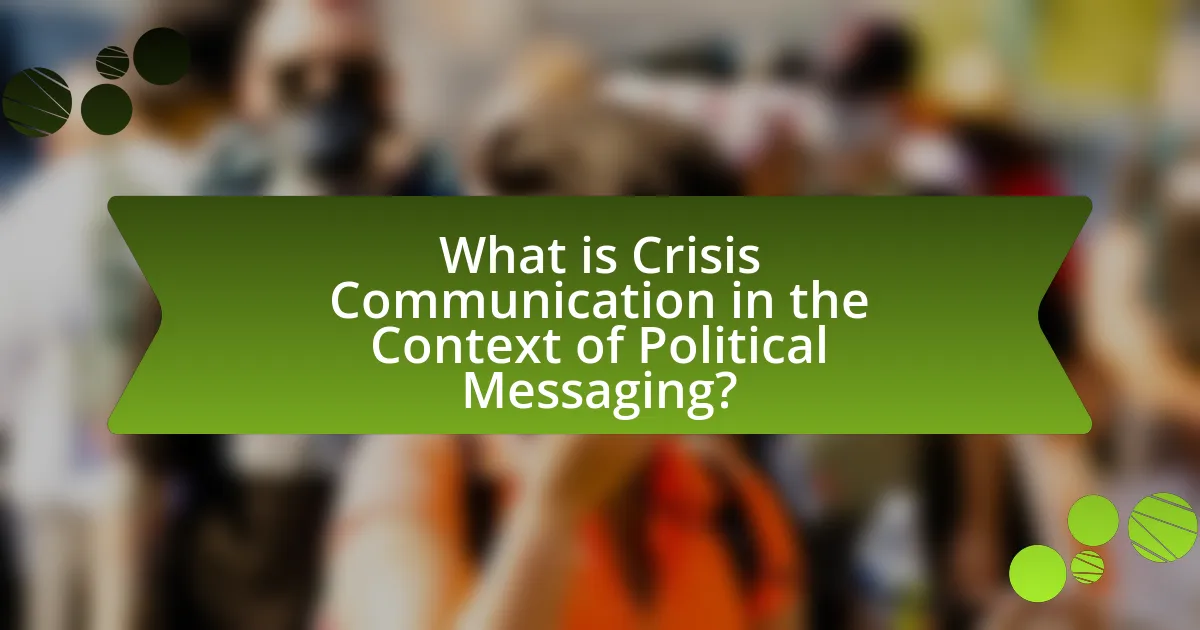
What is Crisis Communication in the Context of Political Messaging?
Crisis communication in the context of political messaging refers to the strategic approach that political entities use to manage and convey information during a crisis to mitigate damage and maintain public trust. This involves timely, transparent, and accurate communication aimed at addressing the concerns of the public and stakeholders while shaping the narrative surrounding the crisis. For instance, during the Watergate scandal, the Nixon administration’s handling of communication significantly impacted public perception and trust, illustrating how effective crisis communication can influence political outcomes.
How does Crisis Communication influence political narratives?
Crisis communication significantly influences political narratives by shaping public perception and framing issues during emergencies. Effective crisis communication strategies can mitigate damage to a political figure’s reputation, as seen in the 2008 financial crisis when leaders who communicated transparently were perceived as more trustworthy. Additionally, the use of social media during crises allows for rapid dissemination of information, enabling political actors to control narratives and counter misinformation, exemplified by the response strategies employed during the COVID-19 pandemic. This control over messaging can lead to shifts in public opinion, as demonstrated by polls indicating increased approval ratings for leaders who effectively communicated during crises.
What are the key elements of effective Crisis Communication?
The key elements of effective crisis communication include timely information dissemination, transparency, empathy, and consistent messaging. Timely information dissemination ensures that stakeholders receive updates as events unfold, which helps to prevent misinformation and speculation. Transparency involves openly sharing facts and acknowledging uncertainties, fostering trust among the audience. Empathy is crucial as it demonstrates understanding and concern for those affected, which can mitigate negative perceptions. Consistent messaging reinforces the organization’s stance and reduces confusion, ensuring that all communications align with the established narrative. These elements are supported by research indicating that organizations that effectively communicate during crises can maintain public trust and minimize reputational damage.
How do political leaders utilize Crisis Communication strategies?
Political leaders utilize Crisis Communication strategies by promptly addressing issues, managing public perception, and providing clear, consistent messaging. During crises, leaders often employ media briefings, social media updates, and public statements to convey their responses and actions, ensuring transparency and accountability. For instance, during the COVID-19 pandemic, leaders like New Zealand’s Prime Minister Jacinda Ardern effectively used daily press conferences to communicate health guidelines and updates, which helped maintain public trust and compliance. This approach demonstrates that timely and accurate information dissemination is crucial in mitigating panic and misinformation, thereby reinforcing the leader’s credibility and authority in times of crisis.
Why is Crisis Communication critical during political crises?
Crisis communication is critical during political crises because it helps manage public perception and maintain trust in leadership. Effective communication during such times can prevent misinformation from spreading, as seen during the 2008 financial crisis when timely updates from government officials helped stabilize markets and public confidence. Additionally, research indicates that transparent communication can mitigate backlash and foster a sense of accountability, which is essential for political stability. For instance, the response to the COVID-19 pandemic highlighted the importance of clear messaging in guiding public behavior and compliance with health measures, ultimately influencing political outcomes.
What are the potential consequences of poor Crisis Communication?
Poor crisis communication can lead to significant reputational damage for organizations and individuals involved. When messages are unclear or inconsistent, stakeholders may lose trust, resulting in decreased public support and potential backlash. For instance, during the 2010 BP oil spill, the company’s failure to communicate effectively exacerbated public outrage and led to a long-lasting negative perception of the brand. Additionally, poor crisis communication can result in misinformation spreading rapidly, further complicating the situation and making it harder to regain control of the narrative. This was evident in the initial responses to the COVID-19 pandemic, where mixed messages from authorities led to confusion and public skepticism. Ultimately, the consequences of inadequate crisis communication can include financial losses, legal repercussions, and long-term damage to credibility and influence in political messaging.
How can effective Crisis Communication mitigate political fallout?
Effective crisis communication can mitigate political fallout by providing timely, transparent, and accurate information to stakeholders, which helps to maintain trust and credibility. When political leaders communicate effectively during a crisis, they can address public concerns, clarify misunderstandings, and prevent the spread of misinformation. For instance, during the COVID-19 pandemic, leaders who communicated clear guidelines and updates, such as New Zealand’s Prime Minister Jacinda Ardern, were able to maintain public trust and compliance, resulting in lower infection rates and political stability. This demonstrates that effective communication not only addresses immediate concerns but also fosters long-term political resilience by reinforcing the leader’s authority and responsiveness.
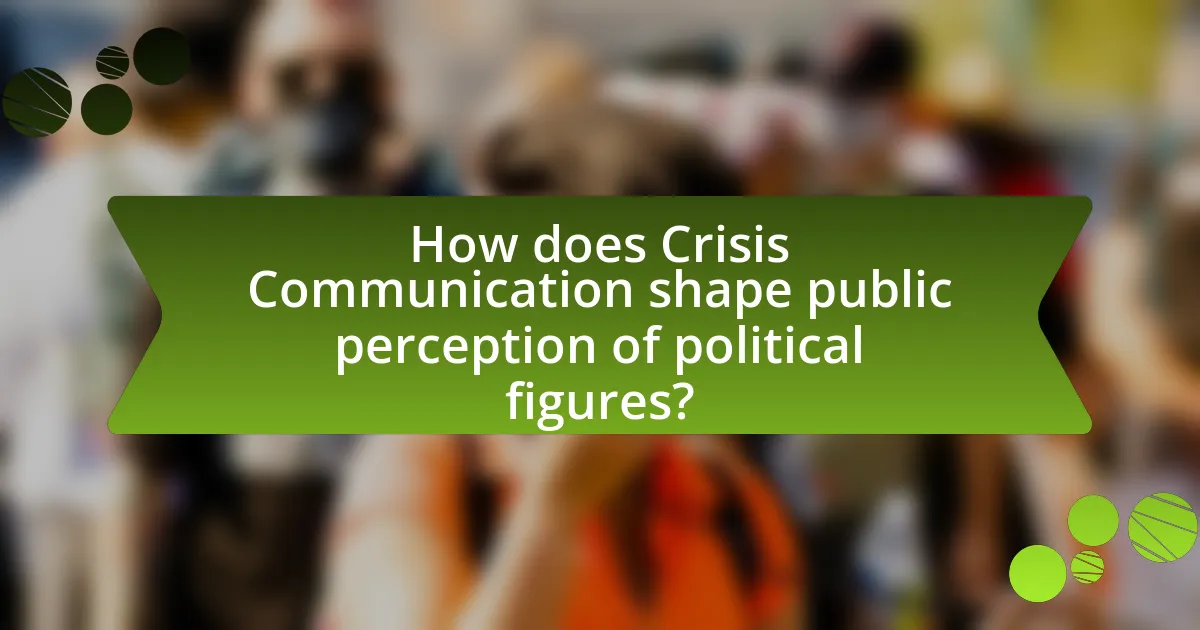
How does Crisis Communication shape public perception of political figures?
Crisis communication significantly shapes public perception of political figures by influencing how information is disseminated and interpreted during critical events. Effective crisis communication strategies can mitigate negative impacts, enhance credibility, and foster trust among constituents. For instance, during the COVID-19 pandemic, leaders who communicated transparently and empathetically, such as New Zealand Prime Minister Jacinda Ardern, experienced higher approval ratings, demonstrating that timely and clear messaging can positively affect public perception. Conversely, political figures who fail to address crises adequately or communicate inconsistently, like former U.S. President Donald Trump during various controversies, often face public backlash and diminished trust. Thus, the manner in which political figures engage in crisis communication directly correlates with their public image and perceived competence.
What role does media play in Crisis Communication for politicians?
Media serves as a critical tool in crisis communication for politicians by shaping public perception and disseminating information rapidly. During a crisis, politicians rely on media outlets to convey their messages, clarify misinformation, and maintain transparency. For instance, in the 2008 financial crisis, U.S. politicians utilized media to communicate their responses and reassure the public, which helped mitigate panic and maintain trust. Furthermore, studies indicate that effective media engagement can significantly influence public opinion, as seen in the aftermath of natural disasters where timely media coverage of government actions can enhance credibility and support.
How do different media platforms affect the dissemination of Crisis Communication?
Different media platforms significantly influence the dissemination of crisis communication by shaping the speed, reach, and engagement of messages. Traditional media, such as television and newspapers, often provide in-depth analysis and context but may have slower dissemination rates compared to digital platforms. In contrast, social media platforms like Twitter and Facebook enable rapid sharing and real-time updates, allowing organizations to reach a broader audience quickly. For instance, during the COVID-19 pandemic, the World Health Organization utilized social media to disseminate critical health information rapidly, reaching millions within hours, which traditional media could not match in terms of immediacy. Furthermore, the interactive nature of social media allows for two-way communication, enabling organizations to address public concerns directly and adjust messaging based on audience feedback, enhancing the overall effectiveness of crisis communication.
What strategies do politicians use to control media narratives during crises?
Politicians use several strategies to control media narratives during crises, including message framing, selective information dissemination, and leveraging social media platforms. Message framing involves presenting information in a way that emphasizes certain aspects while downplaying others, which can shape public perception. For instance, during the COVID-19 pandemic, leaders framed their responses to highlight decisive actions taken, influencing how the public viewed their effectiveness. Selective information dissemination allows politicians to control the flow of information by releasing data that supports their narrative while withholding unfavorable details. An example is the release of positive economic indicators during a financial crisis to maintain public confidence. Additionally, leveraging social media enables politicians to bypass traditional media filters, directly communicating with the public and countering negative narratives in real-time, as seen in various political campaigns where social media was used to address misinformation. These strategies collectively help politicians maintain control over the narrative and influence public opinion during critical times.
How do political messages evolve during a crisis?
Political messages evolve during a crisis by shifting in tone, content, and urgency to address immediate public concerns and maintain trust. During crises, political leaders often adopt a more empathetic and reassuring communication style, focusing on solidarity and collective action. For instance, during the COVID-19 pandemic, many leaders emphasized health and safety measures while also providing economic support information, reflecting the dual nature of public concern. This evolution is supported by research indicating that effective crisis communication enhances public compliance and trust, as seen in studies by the American Psychological Association, which highlight the importance of clear, consistent messaging in maintaining public confidence during emergencies.
What are the stages of message adaptation in Crisis Communication?
The stages of message adaptation in Crisis Communication include assessment, formulation, dissemination, and evaluation. During the assessment stage, communicators analyze the crisis situation and audience needs to understand the context. In the formulation stage, they develop tailored messages that address the specific concerns of the audience while maintaining clarity and transparency. The dissemination stage involves distributing the messages through appropriate channels to ensure maximum reach and impact. Finally, the evaluation stage assesses the effectiveness of the communication efforts, allowing for adjustments in future messaging strategies. These stages are critical for ensuring that communication is effective and responsive during a crisis, as evidenced by successful case studies in crisis management.
How do audience reactions influence message adjustments?
Audience reactions significantly influence message adjustments by providing immediate feedback that communicators can analyze to refine their messaging strategies. For instance, if a political message receives negative reactions on social media, the communicator may adjust the tone, content, or delivery to better align with audience expectations and sentiments. Research indicates that 70% of political campaigns actively monitor audience feedback to adapt their messaging in real-time, ensuring relevance and resonance with constituents. This responsiveness not only enhances engagement but also helps in mitigating potential backlash, demonstrating the critical role of audience reactions in shaping effective communication strategies during crises.
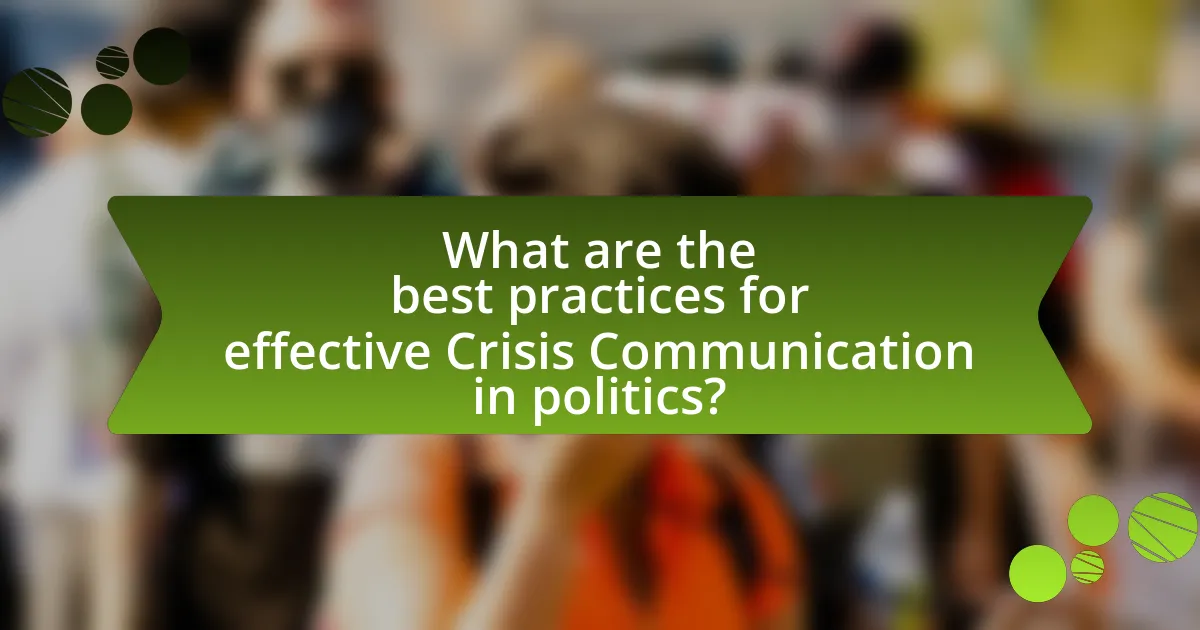
What are the best practices for effective Crisis Communication in politics?
Effective crisis communication in politics requires transparency, timely information dissemination, and a clear, consistent message. Politicians and their teams must prioritize honesty to build trust with the public, as seen in the response to the COVID-19 pandemic, where clear communication from health officials was crucial in managing public perception and behavior. Additionally, utilizing multiple communication channels, such as social media, press conferences, and traditional media, ensures that messages reach diverse audiences quickly. Research indicates that timely updates can significantly reduce misinformation and panic, as demonstrated during the 2010 Haiti earthquake response, where rapid information sharing helped coordinate relief efforts. Furthermore, engaging with stakeholders and the community fosters a sense of inclusion and can mitigate backlash, as evidenced by the successful management of crises in various political campaigns.
How can political leaders prepare for potential crises?
Political leaders can prepare for potential crises by developing comprehensive crisis management plans that include risk assessment, communication strategies, and training for key personnel. These plans should identify potential threats, outline response protocols, and establish clear lines of communication to ensure timely and accurate information dissemination. For instance, the Federal Emergency Management Agency (FEMA) emphasizes the importance of preparedness through exercises and simulations, which help leaders practice their response to various scenarios. Additionally, historical examples, such as the effective communication strategies employed during the COVID-19 pandemic, illustrate how proactive planning can mitigate the impact of crises on public perception and trust.
What tools and resources are essential for Crisis Communication planning?
Essential tools and resources for Crisis Communication planning include a crisis communication plan template, a media contact list, social media monitoring tools, and a crisis management team. A crisis communication plan template provides a structured approach to outline roles, responsibilities, and procedures during a crisis, ensuring that all team members are prepared. A media contact list is crucial for quickly disseminating information to journalists and stakeholders, facilitating timely communication. Social media monitoring tools enable organizations to track public sentiment and respond to misinformation in real-time, which is vital for maintaining credibility. Lastly, a crisis management team, composed of trained individuals, is essential for executing the plan effectively and making informed decisions under pressure. These resources collectively enhance an organization’s ability to manage crises and maintain political messaging integrity.
How can simulations and training improve Crisis Communication readiness?
Simulations and training enhance Crisis Communication readiness by providing realistic scenarios that allow individuals and teams to practice their responses in a controlled environment. These exercises help participants identify potential weaknesses in their communication strategies and improve their ability to convey clear, accurate information under pressure. Research indicates that organizations that engage in regular crisis simulations experience a 30% increase in effective communication during actual crises, as they become more adept at managing stress and uncertainty. This preparedness ultimately leads to more coherent messaging, which is crucial for maintaining public trust and ensuring effective political messaging during crises.
What lessons can be learned from past political crises?
Lessons learned from past political crises include the importance of timely and transparent communication, the need for effective leadership, and the impact of public perception on political stability. Historical examples, such as the Watergate scandal, demonstrate that lack of transparency can erode public trust and lead to significant political fallout. Additionally, the response to the 2008 financial crisis highlighted that decisive leadership and clear messaging can mitigate panic and restore confidence. These instances show that effective crisis communication is crucial in shaping political messaging and maintaining public trust during turbulent times.
Which historical examples highlight the importance of effective Crisis Communication?
The Watergate scandal exemplifies the critical role of effective crisis communication, as it demonstrated how transparent and timely information can influence public perception and political outcomes. During the Watergate crisis in the early 1970s, President Richard Nixon’s administration initially attempted to downplay the break-in at the Democratic National Committee headquarters. However, as evidence mounted and investigative journalism revealed the extent of the cover-up, Nixon’s failure to communicate effectively led to a significant loss of public trust, ultimately resulting in his resignation in 1974. This historical instance underscores that proactive and honest communication is essential in managing crises to maintain credibility and public support.
What common mistakes should be avoided in Crisis Communication?
Common mistakes to avoid in crisis communication include lack of timely information, failure to acknowledge the issue, and inconsistent messaging. Timely information is crucial; delays can lead to misinformation and increased public anxiety. Acknowledging the issue demonstrates transparency and builds trust; ignoring it can exacerbate the situation. Inconsistent messaging confuses the audience and undermines credibility, as seen in various political crises where mixed signals led to public distrust. These mistakes can significantly hinder effective communication and damage reputations.
What practical tips can enhance Crisis Communication strategies?
To enhance Crisis Communication strategies, organizations should prioritize transparency, timely information dissemination, and audience engagement. Transparency builds trust, as seen in the 2014 Ebola outbreak when clear communication from health officials helped mitigate public fear. Timely information dissemination is crucial; research indicates that rapid responses can reduce misinformation spread by up to 70%. Engaging with the audience through social media platforms allows for real-time feedback and clarification, which was effectively utilized during the COVID-19 pandemic by various health organizations. These practical tips are essential for effective crisis management and maintaining public confidence.
